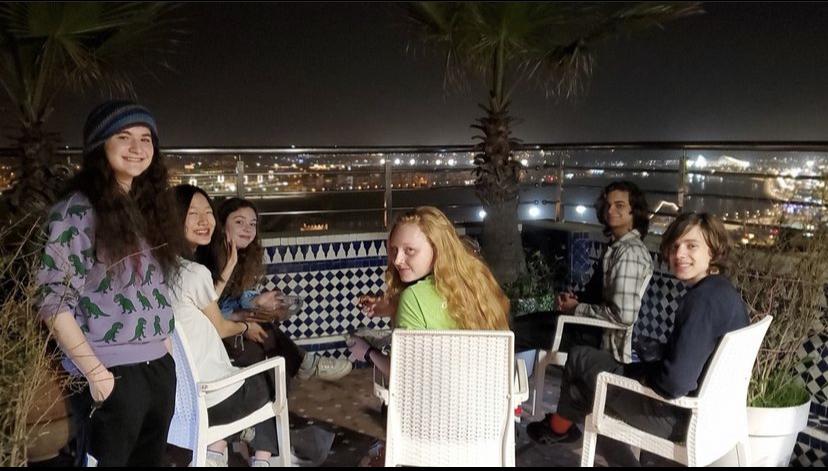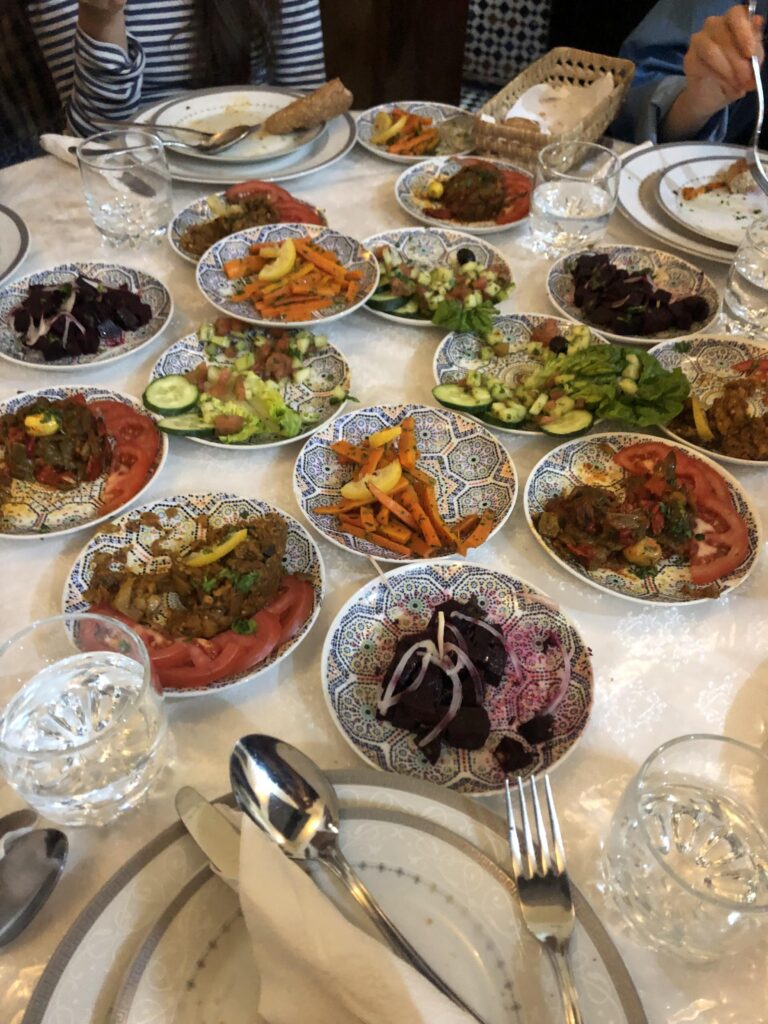In a world full of needless bureaucracy, safety precautions, and insurance, my trip to Morocco felt like standing atop a high mountain from where I could survey the world. Perhaps my image is dramatic, but I’ve yet to hear from a Morocco trip-goer who didn’t find the experience life-changing. This February, twenty-one students, and four chaperones went on a nine-day excursion to the North African country of Morocco. We traveled to the capital city of Rabat, the mountainous town of Chefchaouen, and the major metropolis of Fes. We traveled with our trip organizer Elizabeth Crawford’s long-time friend and tour guide, Rachid—who quickly became a student favorite. (We love you Rachid if you’re reading this!) It took months of work on students’ parts—soliciting donut sales and raking leaves—and loads of planning from our determined and dedicated chaperones, but we finally made it.
The trip there wasn’t great. Our bus was an hour late and it was cold outside; our flight was delayed because of an electrical fire in our terminal. The six-hour bus ride to NYC did not feel short. And the seven hours spent in the airport didn’t go by too quickly either. The flight, another seven sedentary hours, felt like it went on forever—but that may have something to do with my deathly fear of flying and my conviction that I will die the moment I feel any turbulence. Our dinners were spilling over our knees, and my classmates nestled their heads into my shoulders and held my hands when I thought I was done for over the Atlantic ocean. The long customs line was…whatever. We were in Morocco. After nearly twenty-four hours of traveling, we were suddenly in MOROCCO.
We met Rachid at the airport and drove to our first destination, Rabat—one of the three imperial cities of Morocco. We stepped inside the most beautiful hotel I’d ever seen, each room unique with carvings and paintings. We got dressed and walked to dinner. And we ate and ate, and then there was the third course, and I was stuffing myself, but then the fourth course came around and I still tried to eat. And when the fifth course came, I just sat back and looked at it, not daring to touch it for fear my stomach would burst. That’s how most of our lunches and dinners went before we learned to pace ourselves until the last course.
Over the week Rachid would lead us on a tour of the Royal Palace grounds, the Kasbah of the Oudaias in Rabat, and a local ceramicist, along the way, giving us lessons in Moroccan politics and history. But what caught the eye of every student on our trip was the cats. Cats lined the streets everywhere we went, kittens nestled together in piles, catfights, and cats guarding the piers.
With everyone wanting to take a picture of every single cat, walking as a group became difficult at times. At the beach in the morning, there would be plenty of stray dogs as well, following us around until a shopkeeper distracted the herd with food.
We met up with students from an English school in Kenitra, Morocco, on our second day. Over the course of the day, we toured their school as they taught us about the average school day for a Moroccan student, ate lunch (the largest I’ve ever had) with them, and went to the beach.
At the school, we were given a Moroccan history lesson where we learned about the Green March, Morocco’s history of French colonialism, their relationship with a neighboring country, Alergia, and why Morocco’s been featured in so many movies (the good lighting!). The students then paired up with us and taught us a few good-to-know phrases in Arabic. Some of us did very well and others, like me, tried and failed.
In every new city we had a new guide to show us around a few culturally and historically significant locations. In Fes, Fatima told us how Moroccans would bury their dead; in Chefchaouen, our guide explained to us why the city was blue (for tourism reasons mostly).
For a few nights we were able to roam free in groups, getting dinner, coffee, and milkshakes on the street. In Chefchaouen—the Moroccan city we visited closest to Spain—we split up into groups to get dinner, and a few students got to practice their Spanish ordering skills. We wandered the narrow, maze-like alleys, stopping in shops to admire wooden magic boxes and bracelets. The shopkeepers who spoke English questioned us about where we were from one gave us a long spiel about his relationship with his neighbor, and another showed me the photo album from his travels to Germany to see mushrooms, inspired by seeing a mushroom on one of our shirts. Were they talking to us in order to solicit some business? Yes. Did it work? Absolutely.
We were supposed to be bartering. We’d had several lessons on it in Ithaca, and our guide, Rachid, kept drilling it into us as well. We’d barter and buy things and come back to check with Rachid to see if we’d gotten a fair price. Sometimes he’d admit it was a little much, but generally, he saved our pride telling us we’d paid the correct amount. Although a foreign practice to most of us, our group picked up bartering quickly and it became a source of bragging rights as we traveled from market to market. At the end of each day, people proudly recounted the original cost of an item and told us what they’d actually paid. Some were better at it than others—I don’t think I ever had anything to brag about. I found that shopkeepers understood my bargaining psychology immediately. All they had to do was repeat a price twice before I would accept it. Most of my “bargaining” conversations went like this: “It’s 350,” the seller would say. “Can I pay 250?” I’d ask. “Hm, what about 330?” “Does 280 work?” “Will you pay 330?” “Okay.”
Every morning I would get up at seven and explore the city with whomever I could convince to get up with me. I didn’t feel any jet lag; in fact, I didn’t sleep and I didn’t feel tired the whole trip. I was just in awe. I would wake up for the chance to see the city before everyone else; to order a coffee and sit down at a quiet cafe playing the morning news; to jump over dead coral on the beach when only the fishermen were there. And every morning I’d get back to the hotel in time for breakfast: malawach served with cheese, another cup of what seemed like the darkest coffee I’d ever had, fresh squeezed orange juice, and a hard-boiled egg. At night when we had to stay at the hotel I’d go up to the roof and have mindless conversations over the brand name donuts called “Filipinos,” and recap the day while looking over the most beautiful cities all lit up with the moon and stars overhead. I didn’t want to sleep if it meant I was missing one moment in Morocco.
The reason I wrote this piece in the first place isn’t because I want to brag about what a great break I had—at least it wasn’t the main reason. Really, I just hope that this trip, or one like it, will take off every year for decades to come. This is the type of trip that changes our whole world view, that offers the opportunity to experience an often totally new culture with your classmates, whom you will certainly grow far closer to. The importance of this experience is immeasurable and I hope that everyone who sponsored this trip and made this happen for us knows that. I can’t get it out of my head—all I can do is scroll through the photos I took over the short week (over one thousand!) and discover the lost “Tonik” wafer in the bottom of my backpack during class, trying to think about how I felt on that one week in Morocco that now feels like a dream. I hope that as many IHS students as possible get to feel the way I do.

Meeting in the lobby of our hotel in Chefchauoen, Morocco courtesy of Lindsay Wang

Look out at Rabat after dinner on the roof of our hotel. Courtesy of Ms. Shenk

The salad course of our last meal in Rabat, Morocco courtesy of Frances Klemm
